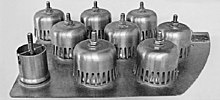Exchange floor
Exchange trays or mass transfer trays are built- in devices or columns in the chemical industry, fiber and paper industry, waste processing and other industrial production processes. Mainly they serve the thermal separation of material systems ( rectification ) or the physical / chemical separation of materials from a product flow ( absorption ). The educts are in the aggregate states of gaseous and liquid. The soils serve as contact levels for both phases and enable the exchange of substances. Another industrially important process is extraction . Mass transfer trays are also used to contact the two immiscible liquid phases.
Mass transfer trays are horizontal internals which are built into the column at certain intervals. Each exchange tray represents a contact level. Basically, mass transfer trays can be distinguished with regard to the direction of flow. Each exchange tray has a layer of liquid through which steam flows through the openings in the tray. This creates an intensely moving bubble layer on the floor. This is where the exchange of heat and substances takes place. As an alternative to the exchange trays, random packings or structured packings are also used in columns .
Types and properties
In the majority of cases, columns are operated in countercurrent due to the greater utilization of the concentration or temperature difference. Replacement floors can still be divided into two main groups.
Cross- flow trays With cross-flow trays, the two phases flow cross-shaped to one another in the contact area. This type is also referred to as forced fluid flow. The steam enters the contact area through specially shaped openings. The liquid is passed through so-called drainage shafts from contact stage to contact stage and enters on one side of the contact area and leaves it again via the drainage shaft. The above A liquid layer forms due to constructional obstacles on the drain, the drain weir and depending on the vapor and liquid load. The cross-flow trays differ in their liquid flow and mass transfer elements. The type of liquid flow must be adapted to the vapor and liquid load. These parameters determine, on the one hand, the diameter of the column / apparatus and, on the other hand, the distance between the contact stages. The liquid flow is also based on these loads and can in some cases only be implemented in certain column diameters. Among others, 1-flow, 2-flow and 4-flow mass transfer trays are the most frequently used types.
Different types of replacement floors:
- High separation performance even with changing throughput rates .
- Very high investments .
- Sieve bottom
- High separation performance only with constant throughput
- Low investment costs within tight throughput limits. Low investment costs.
- Grid floor - Perform-Contact floor
- Average separation performance with constant throughput
- High to very high gas loads are possible
- Low investment costs
- Tunnel floor
- Similar to bell bottom
- Even lower liquid loads are possible
- Often used as a backwash floor
- Valve bottom
- High separation performance even with moderately changing throughput rates.
- Higher investment costs than sieve bottom
Countercurrent trays For countercurrent trays or trays without forced liquid flow, there are no defined areas for steam and / or liquid to flow through. The existing openings, mostly sieve holes, are used by both phases. Due to the special design of these floors, a layer of liquid forms on the floors due to the flow resistance. This is used for the exchange of substances. There are also many different designs here. Probably the simplest is the baffle plate, which is only a horizontal or slightly inclined plate in the column. It typically protrudes slightly above the middle of the column and thus forces the upwardly flowing vapor to come into contact with the liquid as it rains down. Another representative is the dual-flow floor. This is a perforated plate with a certain number of holes. It lies horizontally over the entire cross-section of the column, with vapor and liquid flowing simultaneously through the same holes.
Web links
- RVT mass transfer trays (accessed June 25, 2019)



